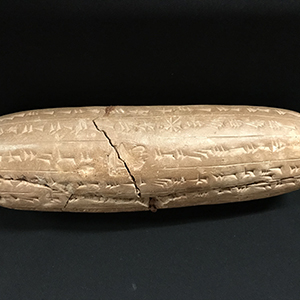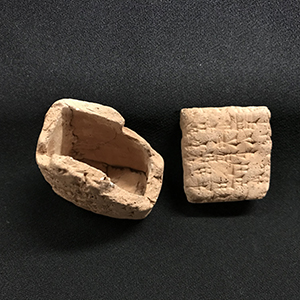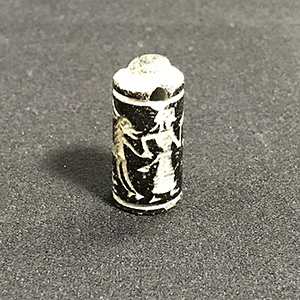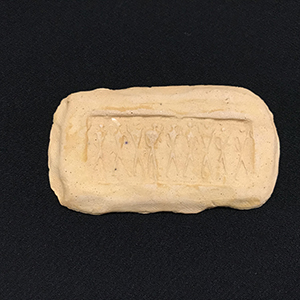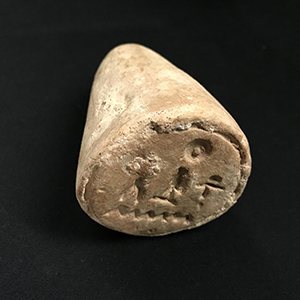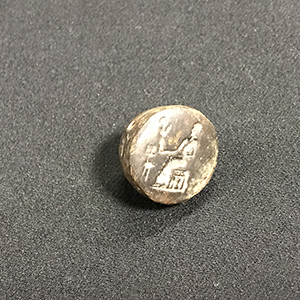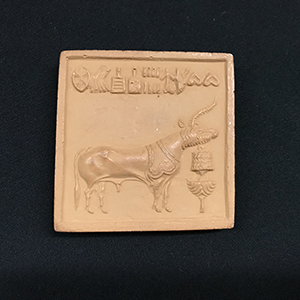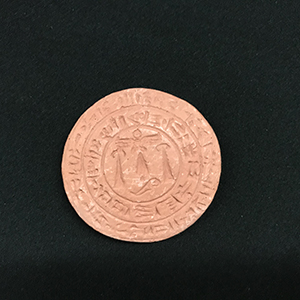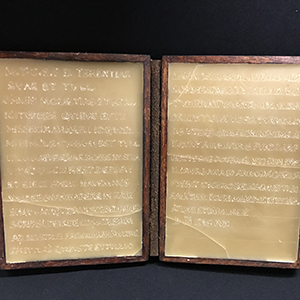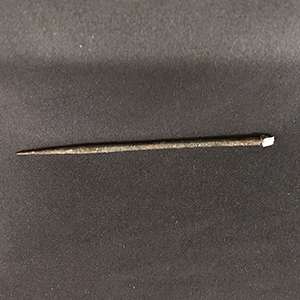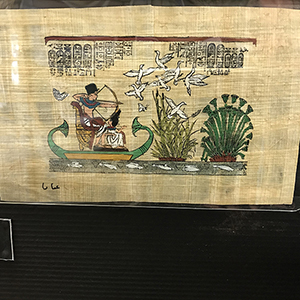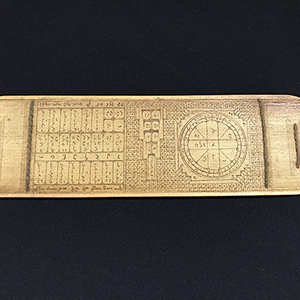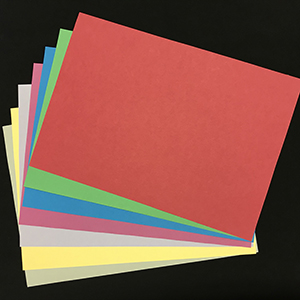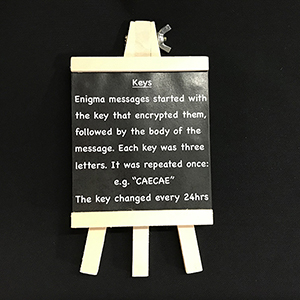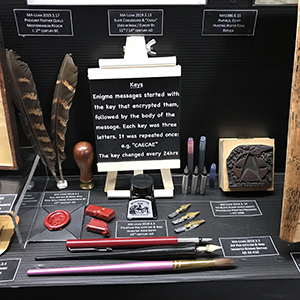Softer media
Although durable, the weight and inflexibility of stone were significant drawbacks for creating, disseminating, and storing large numbers of written messages. For this, lighter, more flexible media were needed. In Mesopotamia clay was used as a writing surface and to create seals (c.3500 BC). In Egypt the papyrus reed was used to create thin, flat, resilient sheets that could be written on (c.3000 BC). Throughout the Mediterranean parchment sheets were created from the skins of calves, goats, and sheep. Wax tablets also appear to have been in use since c.1400 BC. In India and South-East Asia baked palm leaves were used (c.5th century BC), while China used silk (c.3000 BC), bone (c.2000 BC), and bamboo (c.1200 BC) before the invention of paper (c.179 BC), which was later exported to the Arab and European worlds. In this section, “Softer Media” we look at some of the ‘soft’ written artefacts held in UNEMA.
Clay Tablets Ancient Mesopotamia, located between the Tigris and Euphrates rivers, was a land of water and clay. Clay provided a cheap and durable writing medium that was pliable while moist, and hard when sun-dried or baked. Some clay writing tablets reveal that they were made from a complex process of repeatedly rolling and folding together clay sheets (like working puff pastry). Other tablets are little more than crudely squashed lumps of clay. The shape of these writing tablets varied enormously to include barrels, cones, circles, cruciforms, lentils, pillows, prisms, rectangles, and squares. The largest clay tablet in this exhibition is an example of the barrel form. It is a Babylonian cylinder proclaiming the acts of King Esarhaddon (681-669 BC). Cuneiform Stylus and Envelope The cuneiform script (writing) on these tablets was written using a reed stylus. The ‘Giant Reed’ (Arundo donax) was widely used in antiquity to make cuneiform styli, although bone and metal were also used. The Giant Reed was particularly useful as a stylus because its glossy outer skin prevented it from sticking to the clay. To produce cuneiform writing, the corner of the stylus was pressed into the clay where it would leave a wedge-like impression. Three basic wedges were used to create cuneiform symbols: vertical, horizontal, and oblique. Ruled guidelines for writing were created using the stylus, slats, or cords. Both sides of the cuneiform tablet were written on, and most tablets were rotated top to bottom when reading both sides. To protect them from tampering, some clay tablets (like the small one shown in this exhibition), were sealed inside clay envelopes. To access the tablet the envelope had to be broken. This tablet and envelope are an Old Babylonian rental contract, which reads: “SIN-USILI rents a plantation belonging to Enki-Lamazasu in the village of Hansi-PAL […] from IIi-Mahi in the presence of three witnesses (Mat-ilum, Aplum, and IIi-hazir.” Clay Seals Another method of protecting and identifying documents (and goods) was to use seals. Clay seals were created by pressing a matrix, such as a pictorial cylinder or stamp onto wet clay which, when dry, formed a hard seal (impression). These impressions served both as a signature and as a seal protecting documents from unauthorised access. The black stone cylinder matrix displayed here has the image of a man selling an ibex incised on it. When rolled across the clay, the matrix creates an impression that tells the story of the sale. Also shown here is the impression left in clay by a cylinder seal showing a parade of people. This impression was made using a Syrian cylinder seal matrix from the private collection of James Stewart (1913-1962), Australia’s first Professor of Near Eastern Archaeology. Shown here are two examples of seal matrices (above) and seal impressions (below). The large off-white ceramic cone with hieroglyphs on its circular face is a conical seal matrix from ancient Egypt. The smaller, dome-like seal with a circular face showing a seated figure is a signet seal from Mesopotamia. Below these are two seal impressions. The square seal impression showing a horned bull and ornamental stand comes from Mohenjo Daro in Pakistan. The light reddish circular seal impression with central boss surrounded by two lines of text in Ugarit alphabet comes from Syria. Wax tablets and metal stylus In antiquity, wax was set into rectangular wooden frames, which could be hinged together by leather straps. When two, three, or multiple frames were hinged together they were referred to as a diptych, triptych, or polyptych. Using the pointed end of a metal stylus, a writer could scratch messages onto the wax. Using the finial end of the same stylus, a writer could re-smooth the wax to erase any errors. Wax tablets were easily wiped and reused, but messages could also be preserved by closing the hinged frames together and sealing them shut. On display in this exhibition are two replica Roman wax tablets mounted in wooden frames and hinged together with a nailed leather strip. They have been incised with a letter from the Roman statesman Marcus Tullius Cicero to his wife Terentia. Dated 7th June 49 BC, the letter was written five months after the civil war began between Gaius Julius Caesar and Pompey the Great. The Roman stylus on display has a typical point for inscribing wax, and a wedge-shaped finial for smoothing wax. Dated to the 2nd century AD, its patina (tarnished surface) has some inoffensive signs of corrosion. Pliny the Elder’s Natural History, written in the 1st century AD, is the only ancient text that describes the making of papyrus. Papyrus was made in Egypt (c.3000 BC) from a sedge plant that grew on the banks of the river Nile. To make a sheet of papyrus, the reed was cut close to the waterline and its flowering head removed. From the remaining stalk a segment was cut, equal in length to the desired height of the final papyrus sheet. The green outer rind of the stalk was removed to expose the softer white pith beneath. The pith was then cut into strips, similar in thickness to a clarinet reed. These strips were soaked in water to swell their fibres then, while still wet, they were laid out flat, side by side and slightly overlapping. A second layer of strips was added on top, running perpendicular to the first layer. This distinctive pattern of horizontal and vertical fibres can be seen when a papyrus sheet is held up to the light. Both layers were hammered together, pressed flat, and left to dry. Once dry, the strips locked together creating thin, flat, resilient sheets that could be written on with ink. These sheets were also sufficiently resilient to permit ink to be removed by washing or scraping, and for the papyrus to be reused. As a final touch, papyrus sheets were burnished (the surface sanded smooth), and their edges trimmed (smoothed by a pumice stone or shell). A dried, trimmed sheet of papyrus was called a kollema. Scribes normally wrote on the side of the kollema showing horizontal fibres. The sheet of papyrus on display here is hand painted. It depicts a hunter in a boat shooting birds with bow and arrow. Notice the hieroglyphs written in the background. Palm leaves In Asia and India palm leaves have been used for letters, birth calendars (horoscopes), and books (pothi, pustaka, grantha) since at least the 5th century BC. In Asia, palmyra or ola palm leaves were popular, while talipot palm leaves were widely used in India and Sri Lanka. Palm leaves were dried or smoked, cut, pressed flat, trimmed, and sanded smooth. They might be reboiled, dried, sanded, moisturised with oil, and reburnished for added suppleness. Text can be written on both sides of the palm leaf using ink pens and brushes. Traditionally, however, the text was transcribed onto the leaves using a sharp wood or metal stylus (kantas). The scripts used for writing on palm leaf manuscripts tend to be rounder and cursive, because angular letters can tear the leaves. Once the text had been incised, the leaves were coated with ink (masi, mela, lampblack or turmeric mixed with oil), which would seep into the letters. Wiping off the excess ink left the incised letters dark against the lighter leaf. When dried and treated properly, palm leaf manuscripts have survived from several decades to over two thousand years. This small palm leaf tablet from Myanmar has Deva Nagara script on one side and tables of script on the other suggesting an astrological horoscope. The leaves are held together by string woven through holes at the end of each leaf. Parchment Parchment is a sturdy writing sheet made from the skin of a calf, goat, or sheep. To make parchment an individual skin was first soaked in lime water for two days. The skin was then scraped clean of any hair and unwanted refuse, before being stretched with cords on a frame (called a herse). Scraped again with a sharp knife, the skin was left to dry, before being cut up into sheets. The number of sheets produced depended on the size of the animal skin used and the desired size of the parchment to be made. An average calf skin can produce three to four medium-sized writing sheets. By folding one sheet into conjoint leaves (bifolium), the number of writing sheets produced is doubled. Paper Paper is a thin, flat, and flexible medium created by pressing together cellulose fibres from plant and textile matter. Its invention is traditionally ascribed to the Han court eunuch Cai Lun (AD 105). However, a paper map fragment recovered from a Fangmatan tomb dated to 179 BC, suggests that Cai Lun’s achievement was improving the production process of what was in fact a much older invention. Knowledge of papermaking was spread from China to the Middle East in the 8th century, and from there to Europe in the 11th century. In the 19th century paper production was further improved by techniques for pulping wood fibres. The invention of paper permitted a strong reading culture to develop in China, facilitated the increased production of print material, and fostered the development of large libraries. Paper, which was cheaper, lighter, and more versatile than silk, bone, and bamboo, became a vital part of the Chinese arts of calligraphy, painting, and poetry. The ‘four treasures of study’ (wén fáng sì bǎo) were said to be paper, ink, ink brush, and inkstone. Chalk is a calcium carbonate compound derived from mineral chalk rock or limestone. Sticks of chalk can be used to write on slate, blackened boards in shops and classrooms, and even on the ground to create “sidewalk” art. Originally, thin sheets of a hard rock known as slate were used as a reusable writing surface. Chalk writing on slate is easily removed by washing or wiping off the chalk with either a damp or dry cloth. The slate workshop industry reached its peak in the 18th century during the Welsh mining boom. It is unclear when the first writing slates were invented. References suggest that they may have been in use in Europe by the 14th century. According to Abū Rayḥān Muḥammad ibn Aḥmad Al-Bīrūnī Alberuni (AD 973-1050), writing slates were already being used in India in the 11th century AD. Ink Ink is a liquid containing dyes or pigments that can be used to write on a variety of softer media (e.g. bamboo, bone, papyrus, parchment, palm, paper, and silk). The earliest inks are thought to have been black carbon inks. These suspensions were made with lampblack (soot), water, and gum. Later, inks with iron salts (like ferrous sulfate), were created by mixing the tannin obtained from gallnuts (e.g. oak gall) with a thickener, like gum arabic. These inks, which look blue-black when applied, fade to a dull brown. Black carbon inks are relatively chemically stable, whereas iron-inks ‘burn’ the surface of papyrus and parchment, causing damage over time. The two most common inks found on papyrus are black and red. The Romans called their black carbon writing ink atramentum librarium. Red ink was made using mineral iron oxides. The Egyptians are credited with inventing the first artificial pigment: Egyptian Blue. This glass-like pigment was made by heating calcium oxide, copper, and sand quartz together with an alkali, like natron. Malachite, a copper carbonate mineral pigment, was used to make green ink. The bottle of ink on display in this exhibition is Indian ink - a black carbon ink sold ready-made in bottles or as inksticks which need to be ground in an inkstone (mortar) and then water added. Reed Pens The Reed pen was the main ink writing implement of antiquity. They are found in archaeological sites from 800 BC to AD 400. Most were made from the stalks of reeds or bamboo. To make a reed pen one end was cut obliquely to create the nib and its soft interior scraped away. The nib was then given a slit, running almost the length of its centre. This channel is referred to as its capillary. When dipped into ink, the capillary draws up and retains the ink. Then when the nib is pressed onto a writing surface the capillary releases the ink at a steady rate allowing text to be written. Ink Brushes The ink brush, invented in China in c.300 BC, was used in calligraphy and painting. Brush sizes vary greatly according to their purpose. Traditionally the handles were made of bamboo although exotic materials like ivory, jade, and precious metals could be used. Brushes using buffalo, deer, goat, human, mouse, pig, rabbit, tiger, weasel, and wolf hair bristles are known. The bristles can be long, medium, or short, and soft, mixed, or hard. The purple ink brush displayed here has medium-soft bristles. Quills Quills are pens made from feathers. They were the main writing implement of the West from the 6th century AD. The moulted flight feathers of geese, swans, and turkeys were particularly popular. Quill pens were created by scraping smooth the exposed shaft of the feather (calamus). Sometimes the tip was also heated to harden it. The calamus was then whittled to create a shaped nib, usually with a flattened point and channel split (capillary). Like reed pens, when the quill nib was dipped into ink the capillary retained a small amount of ink. The quill could then be used to write with until the ink in the capillary was exhausted and it needed to be re-dipped. Quills were generally lighter and more versatile than reed pens. The two quills on display are pheasant feather quills. Dip Pens Dip pens have metal nibs split by a channel (capillary). The nib is mounted onto the pen handle, which could be made of bone, glass, metal, plastic, or wood. The pen has no reservoir for holding ink and is recharged by being ‘dipped’ into a well, bottle, or bowl of ink. Dip pens can use dye-based inks, pigmented particle-and-binder inks, and gall-based inks, without becoming clogged or corroded. A copper-alloy nib dip pen found in Roman Britain (AD 43-410) is the earliest known dip pen in existence. Dip pens appear to have been in use alongside the quill. The dip pen on display here has a black plastic handle and bronze pen nibs. Fountain Pens Fountain pens also have metal nibs split by a channel (capillary). These pens, however, have an ink reservoir which replaces the need to dip the pen into ink, and increases the time required before a recharge of ink is needed. They are said to have been invented when the Calif of Egypt, Abu Tamim Maad al-Mu’izz li-Dinillah (c.AD 953) desired to have a pen that would not stain his clothes or hands or require dipping. Fountain pens tend to use dye-based inks because the solid particles in pigment inks and their gum arabic binder, tend to clog the capillary of the pen’s nib, while gall-based inks corrode them. The red fountain pen on display has silver screw-in nibs. Also on display are a black ink and a red ink full chamber refill and a blue ink half chamber refill.